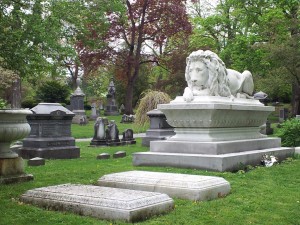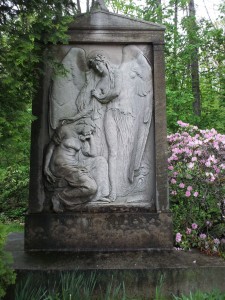Lowell Cemetery Monuments as Public Art (Commentary)
The Lowell Cemetery as a Place of Public Art
by Heidrun Ryan
Cemeteries are, perhaps, of greatest importance to the living. The monuments are meant to be seen: while personal, they may also be a source of both history and art for the larger community. The Lowell Cemetery is intimately connected to the community by the burial here of prominent Lowellians whose names can be seen on street signs all around Lowell. In an era which did not yet include public parks, “rural” cemeteries such as this one were to offer a place of recreation, including lessons in history, poetry, art, and architecture, to their visitors, some of whom might never see art in any other setting. Located about two miles from downtown Lowell, the cemetery was away from the mills and shops, but close enough to be within easy reach of visitors. The Lowell Cemetery can rightfully be counted among the treasures of Lowell’s public art.
The cemetery contains several works designed and executed by artists who were sought out because of their reputation, usually by prominent citizens. Two of these were highlighted in a recent (May 5, 2012) public tour of the cemetery given by Richard Howe, the Register of Deeds for Middlesex North and historian. The Ayer Lion serves as a monument to James Cook Ayer. From his vast fortune acquired as a patent medicine entrepreneur, Ayer gave the city its Winged Victory statue, which stands before City Hall. Ayer’s widow and children commissioned the London-based sculptor Albert Bruce Joy to make a suitable monument. The lifelike lion with the mournful face implies that only a person at the top of society would fittingly be mourned and guarded by “the king of beasts.” It is not known if Ayer himself had any say in the choice of this regal design for his monument; he was, as Howe related to the assembled visitors, confined to an insane asylum for the last years of his life. Certainly, this sculpture testifies to the wealth and status of the inhabitants of the family plot.
By contrast, the Mill Girl monument was dedicated to Louisa Wells, a “Lowell Mill Girl” who lived modestly and never married. Her will, which some cousins promptly contested after her death in 1866, directed her savings to be used for a grave marker. By the time the matter was settled (in her favor) twenty years later, the sum was large enough that the executor of her estate felt himself able to offer the job to Daniel Chester French, sculptor of the Lincoln Memorial. French himself declined, but gave the commission to his associate, Evelyn Longman. Howe pointed out that the mill worker in the monument is a weaver, Wells’s own profession; she holds a bobbin and strands of yarn on her lap, ritually cut to indicate the end of life. The inscription reads, “Out of the fibre of her daily tasks / She wove the fabric of a useful life.” Longman’s sensitive design and skillful rendering of facial features and drapery elevate this piece beyond that of graveside memorial; it celebrates and ennobles all of Lowell’s humble “Mill Girls” and reminds us that it is not only the rich and famous who are buried here; people from all walks of life are represented.
These representative works from the Lowell Cemetery illustrate the powerful connection this site has to the community of Lowell. Each monument tells its own story, but it is the entire site that evokes the memory of the city. It recalls a time when Lowell acquired for itself the fashionable “rural” cemetery which helped define its place in the forefront of American society. Individually and collectively, this remarkable open-air gallery represents the workers, the immigrants, and the titans of capital so vital to Lowell’s growth throughout its history. It unites private and public memory, nature and art, past and present. Lowell is reclaiming its present through its past, and the public tours offered at the Lowell Cemetery are part of the effort. As Richard Howe explained, the cemetery will be the endpoint of the Concord River Greenway, which will bind this site even more closely to Downtown Lowell. The gravesite of Senator Paul Tsongas, an enthusiastic and vocal advocate for Lowell’s revival and its Public Art Collection, fittingly overlooks the river and the end of the Greenway.
Principal Sources: Richard Howe, tour; Amos Blanchard, “An Address Delivered at the Consecration of the Lowell Cemetery, June 20, 1841” (Lowell: Leonard Huntress, 1841); John Gary Brown, Soul in the Stone: Cemetery Art from America’s Heartland (Lawrence, KS: University of Kansas Press, 1994).
Photos by Heidrun Ryan.


The Cemetary is beautiful in all weather, hot, cold or snowy.